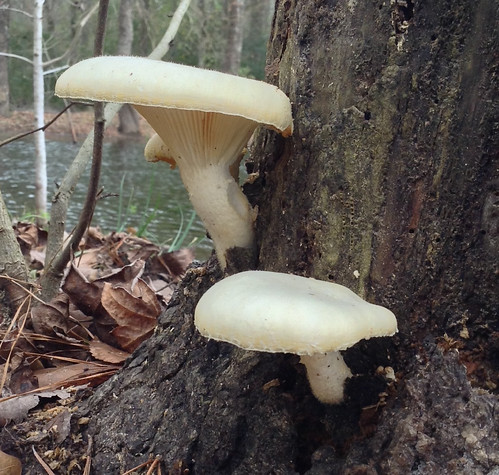Scientific Name(s): Hypsizygus ulmarius
Abundance: uncommon
What: cap, stem
How: cooked
Where: on dead wood
When: fall, winter, spring
Nutritional Value: Dangers: Don't mistake Jack O'Lantern mushrooms (Omphalotus olearius) for oyster mushrooms.
COLLECTING MUSHROOM REQUIRES 100% CERTAINTY. WWW.FORAGINGTEXAS.COM ACCEPTS NO RESPONSIBILITY FOR IDENTIFICATION ERRORS BY ANY READERS.
Growth Form: Hypsizygus ulmarius often grows in clusters, typically on living or dead wood of deciduous trees, with elms being their preferred substrate. They often have a more "toadstool" shape than
common oyster mushrooms.
Cap Shape and Size: The cap is initially convex, becoming more flattened with age, measuring 3 to 6 inches in diameter. It is white to cream in color, sometimes with a brownish center.
Gills or Pores: The gills are white, becoming cream-colored with age, and are attached or slightly running down the stem (adnate to subdecurrent).
Stipe Characteristics: The stipe is 1 to 3 inches long and 0.5 to 1.5 inches thick, white, sometimes scaly, and sometimes enlarges at the base.
Odor: This species typically has a mild, not distinctive odor.
Bruising: There is no significant color change on bruising.
Spore Color: The spore print is white.
Substrate and Habitat: Found predominantly on hardwoods, especially elm, and beech trees.
Other Characteristics: Known for its preference for growing on elm trees and its thick, meaty flesh. The mushroom is edible and valued for its texture and mild flavor.
Young elm oyster (Hypsizygus ulmarius) mushrooms growing on a dead tree.

Same mushrooms from a slightly different angle.

Another elm oyster from two angles.


The most apparent difference between common and elm oyster mushrooms is the stipe. Elm oysters will generally have a thick, round stipe 1"-2" long whereas the common oyster is usually attached directly to the tree without a distinct stipe.
Use these just as you would any store-bought white, button mushroom...but be sure to cook it. Wild mushrooms will always have a certain amount of bugs, bug larva, and bug eggs in them, so cooking is necessary to kill the extra, protein-filled critters.
Elm oysters prefer hardwoods, especially damaged elm trees. You will not find them on pines or cedars.





